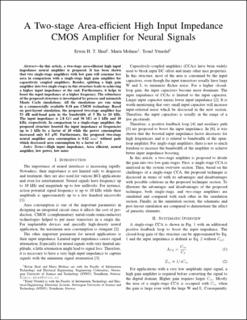| dc.contributor.author | Habibzadeh Tonekabony Shad, Erwin | |
| dc.contributor.author | Molinas Cabrera, Maria Marta | |
| dc.contributor.author | Ytterdal, Trond | |
| dc.date.accessioned | 2021-10-28T08:39:19Z | |
| dc.date.available | 2021-10-28T08:39:19Z | |
| dc.date.created | 2021-08-10T12:30:34Z | |
| dc.date.issued | 2021 | |
| dc.identifier.isbn | 978-1-6654-3085-2 | |
| dc.identifier.uri | https://hdl.handle.net/11250/2826196 | |
| dc.description.abstract | In this article, a two-stage area-efficient high input impedance neural amplifier is proposed. It has been shown that two single-stage amplifiers with low gain will consume less area in comparison with a single-stage high gain amplifier for capacitively coupled amplifiers. Besides, splitting a high gain amplifier into two single-stages in this structure leads to achieving a higher input impedance at the end. Furthermore, it helps to boost the input impedance at a higher frequency. The robustness of the proposed structure is investigated by process and mismatch Monte Carlo simulations. All the simulations are run using in a commercially available 0.18 μm CMOS technology. Based on post-layout simulation, the proposed two-stage amplifier has 53 dB mid-band gain in the bandwidth of 5 Hz to 10 kHz. The input impedance is 2.8 GΩ and 56 MΩ at 1 kHz and 10 kHz, respectively. In comparison to a single-stage amplifier, the proposed structure boosted the input impedance at frequencies up to 1 kHz by a factor of 10 while the power consumption increased only 0.5 μW. Furthermore, the proposed two-stage neural amplifier area consumption is 0.02 mm 2 without pads which decreased area consumption by a factor of 3. | en_US |
| dc.language.iso | eng | en_US |
| dc.publisher | Institute of Electrical and Electronics Engineers (IEEE) | en_US |
| dc.relation.ispartof | 2021 IEEE International Conference on Design & Test of Integrated Micro & Nano-Systems (DTS) | |
| dc.title | A Two-stage Area-efficient High Input Impedance CMOS Amplifier for Neural Signals | en_US |
| dc.type | Chapter | en_US |
| dc.description.version | acceptedVersion | en_US |
| dc.rights.holder | © IEEE. Personal use of this material is permitted. Permission from IEEE must be obtained for all other uses, in any current or future media, including reprinting/republishing this material for advertising or promotional purposes, creating new collective works, for resale or redistribution to servers or lists, or reuse of any copyrighted component of this work in other works. | en_US |
| dc.identifier.doi | 10.1109/DTS52014.2021.9498105 | |
| dc.identifier.cristin | 1925006 | |
| cristin.ispublished | true | |
| cristin.fulltext | postprint | |
| cristin.qualitycode | 1 | |
